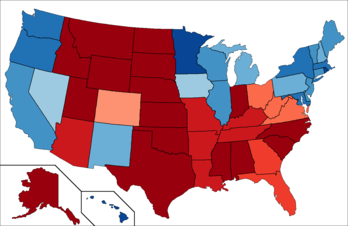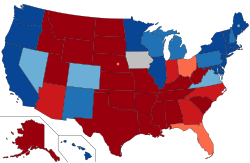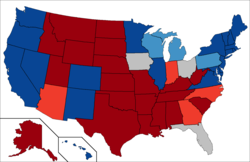
The 1964 United States presidential election was the 45th quadrennial presidential election. It was held on Tuesday, November 3, 1964. Incumbent Democratic President Lyndon B. Johnson defeated Republican Senator Barry Goldwater in a landslide victory. Johnson was the fourth and most recent vice president to succeed the presidency following the death of his predecessor and win a full term in his own right. Johnson won the largest share of the popular vote for the Democratic Party in history, 61.1%, and the highest for any candidate since the advent of widespread popular elections in 1824.
The New Deal coalition was an American political coalition that supported the Democratic Party beginning in 1932. The coalition is named after President Franklin D. Roosevelt's New Deal programs, and the follow-up Democratic presidents. It was composed of voting blocs who supported them. The coalition included labor unions, blue-collar workers, big city machines, racial and religious minorities, white Southerners, and intellectuals. Besides voters the coalition included powerful interest groups: Democratic Party organizations in most states, city machines, labor unions, some third parties, universities, and foundations. It was largely opposed by the Republican Party, the business community, and rich Protestants. In creating his coalition, Roosevelt was at first eager to include liberal Republicans and some radical third parties, even if it meant downplaying the "Democratic" name. By the 1940s, the Republican and third-party allies had mostly been defeated. In 1948, the Democratic Party stood alone and survived the splits that created two splinter parties.
American electoral politics have been dominated by successive pairs of major political parties since shortly after the founding of the republic of the United States. Since the 1850s, the two largest political parties have been the Democratic Party and the Republican Party—which together have won every United States presidential election since 1852 and controlled the United States Congress since at least 1856. Despite keeping the same names, the two parties have evolved in terms of ideologies, positions, and support bases over their long lifespans, in response to social, cultural, and economic developments—the Democratic Party being the left-of-center party since the time of the New Deal, and the Republican Party now being the right-of-center party.
A political realignment, often called a critical election, critical realignment, or realigning election, in the academic fields of political science and political history, is a set of sharp changes in party ideology, issues, party leaders, regional and demographic bases of power of political parties, and the structure or rules of the political system, such as voter eligibility or financing. The changes result in a new political power structure that lasts for decades, replacing an older dominant coalition. Scholars frequently invoke the concept in American elections and occasionally those of other countries. American examples include the 1896 United States presidential election, when the issues of the American Civil War political system were replaced with those of the Populist and Progressive Era, and the 1932 United States presidential election, when the Populist and Progressive Eras were replaced by the New Deal-era issues of New Deal liberalism and modern conservatism. Realigning elections typically separate party systems—with 1828, for example, separating the First Party System and the Second Party System in the US. It is generally accepted that the United States has had five distinct party systems, each featuring two major parties attracting a consistent political coalition and following a consistent party ideology, separated by four realignments.

In American politics, the Southern strategy was a Republican Party electoral strategy to increase political support among white voters in the South by appealing to racism against African Americans. As the civil rights movement and dismantling of Jim Crow laws in the 1950s and 1960s visibly deepened existing racial tensions in much of the Southern United States, Republican politicians such as presidential candidate Richard Nixon and Senator Barry Goldwater developed strategies that successfully contributed to the political realignment of many white, conservative voters in the South who had traditionally supported the Democratic Party. It also helped to push the Republican Party much more to the right relative to the 1950s. By winning all of the South a presidential candidate could obtain the presidency with minimal support elsewhere.

The American Voter, published in 1960, is a seminal study of voting behavior in the United States, authored by Angus Campbell, Philip Converse, Warren Miller, and Donald E. Stokes, colleagues at the University of Michigan. Among its controversial conclusions, based on one of the first comprehensive studies of election survey data, is that most voters cast their ballots primarily on the basis of partisan identification, and that independent voters are actually the least involved in and attentive to politics. This theory of voter choice became known as the Michigan Model. It was later extended to the United Kingdom by David Butler and Donald Stokes in Political change in Britain.
An independent voter, often also called an unaffiliated voter or non-affiliated voter in the United States, is a voter who does not align themselves with a political party. An independent is variously defined as a voter who votes for candidates on issues rather than on the basis of a political ideology or partisanship; a voter who does not have long-standing loyalty to, or identification with, a political party; a voter who does not usually vote for the same political party from election to election; or a voter who self-describes as an independent.

The politics of the Southern United States generally refers to the political landscape of the Southern United States. The institution of slavery had a profound impact on the politics of the Southern United States, causing the American Civil War and continued subjugation of African-Americans from the Reconstruction era to the Civil Rights Act of 1964. Scholars have linked slavery to contemporary political attitudes, including racial resentment. From the Reconstruction era to the Civil Rights Act of 1964, pockets of the Southern United States were characterized as being "authoritarian enclaves".

The Third Party System was a period in the history of political parties in the United States from the 1850s until the 1890s, which featured profound developments in issues of American nationalism, modernization, and race. This period, the later part of which is often termed the Gilded Age, is defined by its contrast with the eras of the Second Party System and the Fourth Party System.
These are the references for further information regarding the history of the Republican Party in the U.S. since 1854.

The Republican Party, also known as the GOP, is one of the two major political parties in the United States. It is the second-oldest extant political party in the United States after its main political rival, the Democratic Party.

The Fourth Party System was the political party system in the United States from about 1896 to 1932 that was dominated by the Republican Party, except the 1912 split in which Democrats captured the White House and held it for eight years.

The Fifth Party System, also known as the New Deal Party System, is the era of American national politics that began with the election of Franklin D. Roosevelt to President of the United States in 1932. Roosevelt's implementation of his popular New Deal expanded the size and power of the federal government to an extent unprecedented in American history, and marked the beginning of political dominance by the Democratic Party that would remain largely unbroken until 1952. This period also began the ideological swapping of Democrats and Republicans into their modern versions, largely due to most Black voters switching from the Republican Party to the Democratic Party, while most conservative, White, usually southern Democrats shifted to the Republican Party as Democrats began increasingly prioritizing civil rights; this process accelerated into the 1960s. The Fifth Party System followed the Fourth Party System, also known as the Progressive Era, and was itself followed by the Sixth Party System.
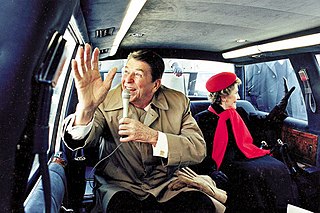
This is the electoral history of Ronald Reagan. Reagan, a Republican, served as the 40th president of the United States (1981–1989) and earlier as the 33rd governor of California (1967–1975). At 69 years, 349 days of age at the time of his first inauguration, Reagan was the oldest person to assume the presidency in the nation's history, until Donald Trump was inaugurated in 2017 at the age of 70 years, 220 days. In 1984, Reagan won re-election at the age of 73 years, 274 days, and was the oldest person to win a US presidential election until Joe Biden won the 2020 United States presidential election at the age of 77 years, 349 days.

The 1980 United States elections were held on Tuesday, November 4. Republican presidential nominee Ronald Reagan defeated incumbent Democratic President Jimmy Carter in a landslide. Republicans picked up seats in both chambers of Congress and won control of the Senate, though Democrats retained a majority in the House of Representatives. The election is sometimes referred to as part of the "Reagan Revolution", a conservative realignment in U.S. politics and marked the start of the Reagan Era.

The Reagan era or the Age of Reagan is a periodization of recent American history used by historians and political observers to emphasize that the conservative "Reagan Revolution" led by President Ronald Reagan in domestic and foreign policy had a lasting impact. It overlaps with what political scientists call the Sixth Party System. Definitions of the Reagan era universally include the 1980s, while more extensive definitions may also include the late 1970s, the 1990s, and even the 2000s. In his 2008 book, The Age of Reagan: A History, 1974–2008, historian and journalist Sean Wilentz argues that Reagan dominated this stretch of American history in the same way that Franklin D. Roosevelt and his New Deal legacy dominated the four decades that preceded it.

The 1984 United States presidential election in Idaho took place on November 6, 1984. All 50 states and the District of Columbia, were part of the 1984 United States presidential election. State voters chose four electors to the Electoral College, which selected the president and vice president of the United States. Idaho was won by incumbent United States President Ronald Reagan of California, who was running against former Vice President Walter Mondale of Minnesota. Reagan ran for a second time with incumbent Vice President and former C.I.A. Director George H. W. Bush of Texas, and Mondale ran with Representative Geraldine Ferraro of New York, the first major female candidate for the vice presidency.
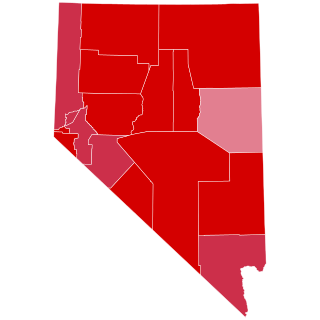
The 1984 United States presidential election in Nevada took place on November 6, 1984. All 50 states and the District of Columbia, were part of the 1984 United States presidential election. State voters chose four electors to the Electoral College, which selected the president and vice president of the United States.

The 1984 United States presidential election in Colorado took place on November 6, 1984. All 50 states and the District of Columbia, were part of the 1984 United States presidential election. State voters chose eight electors to the Electoral College, which selected the president and vice president of the United States. Colorado was won by incumbent United States President Ronald Reagan of California, who was running against former Vice President Walter Mondale of Minnesota. Reagan ran for a second time with incumbent Vice President and former C.I.A. Director George H. W. Bush of Texas, and Mondale ran with Representative Geraldine Ferraro of New York, the first major female candidate for the vice presidency.
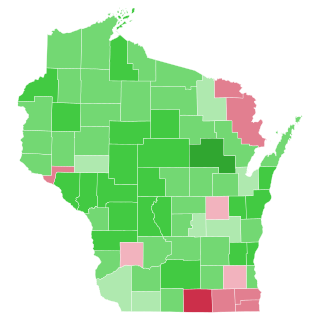
The 1924 United States presidential election in Wisconsin was held on November 4, 1924 as part of the 1924 United States presidential election. State voters chose 13 electors to the Electoral College, who voted for president and vice president.

